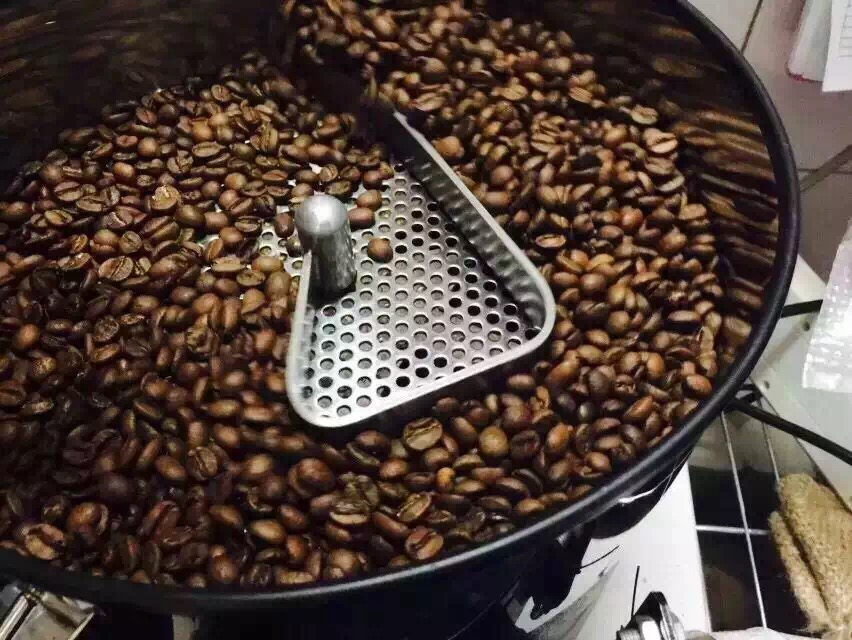作者:未知 来源:手冲咖啡: 咖啡知识 > 咖啡烘焙 > 2025-12-30 21:42:16

原文:
Basic Chemical Reactions Occurring in the Roasting Process
by Carl Staub
sourced from the SCAA Roast Color Classification System developed by Agtron - SCAA in 1995
Many thermal and chemical reactions occur during the roasting process: decarboxylation, dehydration of quinic acid moiety, fractionization, isomerization, polymerization, and complex sugar reactions. The principal thermally reactive components are monosaccharides and sucrose, chlorogenic acids, free amino acids, and trigonelline. Both aravinose and calactose of polysaccharides are splitoff and the basic sulfur containing and hydroxyamino acids decompose. Carbohydrates both polymerize and degrade, liberating thermally unstable monosaccharides decomposing 20-30% of the polysaccharides, depending on the degree of roast.
Sucrose: Disaccharide of d-Glucosyl and d-Fructosyl Moieties
Sucrose is the principle sugar in coffee. The melting point of pure crystalline sucrose is in the 320-392 degrees F with 370 degrees F most commonly accepted. Degradation of dry sucrose can occur as low as 194 degrees F. and begins with the cleavage of the glycosidic bond followed by condensation and the formation of water. Between 338 and 392 degrees F, carmelization begins. It is at this point that water and carbon dioxide fracture and out-gassing begins causing the first mechanical crack. These are the chemical reactions, occurring at approximately 356 degrees F, that are exothermic. Once carmelization begins, it is very important that the coffee mass does not exotherm (lose heat) or the coffee will taste "baked" in the cup. A possible explanation is that exothermy of the charge mass interrupts long chain polymerization and allows cross linking to other constituents. Both the actual melting point of sucrose and the subsequent transformation, or carmelization, reaction are effected by the presence of water, ammonia, and proteinatious substances. Dark roasts represent a higher degree of sugar carmelization than light roasts. The degree of carmelization is an excellent and high resolution method for classifying roasts.
Cellulose: A Long Linear Polymer of Anhydroglucose Units
Cellulose is the principle fiber of the cell wall of coffee. It is partially ordered (crystalline) and partially disordered (amorphous). The amorphous regions are highly accessible and react readily, but the crystalline regions with close packing and hydrogen bonding may be completely inaccessible. Native cellulose, or cellulose 1, is converted to polymorphs cellulose III and cellulose IV when exposed to heat. Coffees structure is a well developed matrix enhancing the mass uniformity and aiding in the even propagation of heat during roasting. Cellulose exists in coffee imbedded in lignocellulose (an amorphous matrix of hemicellulose and lignin containing cellulose), making up the matrix cell walls. Hemicellusloses are polysaccharides of branched sugars and uronic acids. Lignin is of special note because it is a highly polymerized aromatic. Severe damage occurs to the cell walls of the matrix at distributed temperatures above 446 degrees F and bean surface temperatures over 536 degrees F The actual temperature values will change due to varying levels of other constituents. Second crack, associated with darker roasts, is the fracturing of this matrix, possibly associated with the volatilization of lignin and other aromatics. Under controlled roasting conditions, the bean environment temperature should never exceed 536 degrees F. A wider safety margin would be achieved by limiting the maximum environment temperature to 520 degrees F. These temperature limits minimize damage to the cell matrix and enhances cup complexity, roasting yield, and product shelf life.
Trigonelline: A Nitrogenous Base Found in Coffee
Trigonelline is 100% soluble in water and therefore will end up in the cup. Trigonelline is probably the most significant constituent contributing to excessive bitterness. At bean temperatures of 445 degrees F, approximately 85% of the trigonelline will be degraded. This bean temperature represents a moderately dark roast. For lighter roasts there will be more trigonelline, hence bitterness, but also less sugar carmelization. Caramelized sugar is less sweet in the cup than noncaramelized sugar, so when properly roasted these two constituents form an interesting compliment to each other. Trigonelline melts in it's pure crystalline form at 424 degrees F Degradation of trigonelline begins at approximately 378 degrees F.. The degradation of trigonelline is one of the key constituent control flags for determining the best reaction ratio.
Quinic Acid: Member of the Carboxylic Acids Group
Quinic Acid melts in pure crystalline form at 325 degrees E, well below the temperatures associated with the roasting environment. Quinic Acid is water soluble and imparts a slightly sour (not unfavorably as in fermented beans) and sharp quality, which adds to the character and complexity of the cup. Surprisingly, it adds cleanness to the finish of the cup as well. it is a stable compound at roasting temperatures.
Nicotinic Acid: Member of the Carboxylic Acid Group
Nicotinic Acid melts in pure crystalline form at 457 degrees F. Naturally occurring Nicotinic Acid is bound to the polysaccharide cellulose structure. Nicotinic Acid is also derived in soluble form during roasting. Higher levels of Nicotinic Acid for any given degree of roast are associated with better cup quality. Since it is I 00% soluble, it will end up in the cup. Nicotinic Acid contributes to favorable acidity and clean finish. It's derivation rate is one of the key constituent control flags for determining the best reaction ratio temperature and chemistry propagation rates. Additionally, the interaction of melted Nicotenic Acid with other constituents contributes significantly to the intensity associated with darker roasts.
Environment Temperature
The temperature of the roasting environment determines the specific types of chemical reactions that occur. There is a window of temperatures that produce favorable reactions for the ideal cup characteristics. Temperature values outside of this window have a negative effect on quintessential cup quality. Even within the window values, different temperatures will change the character of the cup, giving the roaster the latitude to develop a personality or style desired, or to tame the rough signature of certain coffees while still optimizing relative quality. System Energy: At any given environment temperature, the amount of energy (BTU) and the roasting system's transfer efficiency will determine the rate at which the specific chemistrywilloccur. Higher levels of both energy andt ransfer efficiency will cause the reactions to progress more quickly. There is a window of reaction rates that will optimize cup quality. This is called the Best Reaction Ratio, or BRR.
Best Reaction Ratio (BRR)
The best cup characteristic are produced when the ratio of the degradation of trigonelline to the derivation of Nicotinic Acid remains linear. The control model of this reaction ratio is a time/temperature/energy relationship. The environment temperature (ET) establishes the pyrolysis region for the desired chemical reactions while the energy value (BTU) and system transfer efficiency (STE) determines the rate of reaction propagation and linearity of Nicotinic Acid derivation to degradation of trigonelline. Because green bean density varies dramatically, under any given ET / BTU / STE format, the reaction distribution will vary. it takes longer to obtain comparable uniformity for a higher density bean. Monitoring the bean temperature offers a good method of approximating the reaction distribution during this phase of the roasting. The ideal environmental temperature, ET, for best reaction ratio, BRR, is from -401-424 degrees F, with 405 degrees F as the default value. The BTU required is determined by the systems transfer efficiency, or ability to impart the energy to the charge mass.
Maximum Environment Temperature (MET)
Establishing the thermal environment protocol for the ideal roast is a balancing act. While it is desirable to maintain the BRR temperature and energy levels until the target reactions are achieved, the BRR temperature is well above the carmelization temperature of sucrose. Because many roasting systems exhibit thermal hysterysis using simple temperature regulating schemes, care must be taken not to allow the coffee mass to exotherm. Additionally, limiting the maximum environment temperature, MET, is also important. As previously mentioned, maintaining structural integrity of the cellulose matrix is of great importance. Lower temperatures will reduce surface evaporation of constituents minimizing the capillary action that draws constituents to the surface where they would be volatilized. Hydraulic action, a function of internal pressure which is directly related to bean temperature, is already at work. By limiting the maximum temperature, losses will be minimized and the essence of coffee retained. Consequently, the MET should not exceed 520 degrees F. This roasting system bases the MET value on the actual final bean, or drop temperature, which correlates to the degree of roast.
译文
在烘焙过程中发生了很多热与化学反应:去碳酸基,奎宁酸的脱水,细分,异构化,聚合,以及复杂的糖反应(焦糖化)。主要的热反应的组件有:单糖和蔗糖、绿原酸、流离氨基酸,以及葫芦巴酰胺。多糖中的aravinose和calactose都被转移,基本的硫化处理包含了羟氨酸分解。碳水化合物同时被聚合及分解,视烘焙的程度,20-30%的多糖会被分解,释放出热不稳定的单糖。
蔗糖: D-葡萄糖和D- fructosyl 各一半构成的双糖
蔗糖是咖啡中主要的糖。纯结晶蔗糖的熔点是320-392华氏度(160-200摄氏度),公认的熔点是 370华氏度(187.8摄氏度)。退化的干蔗糖的熔点可以低至194华氏度(90摄氏度),并随着脱水和浓缩,糖开始分裂成糖苷结合物。 在338和392华氏度(170和200摄氏度)之间,焦糖化反应开始。正是在这一点上,水和二氧化碳破裂,由此造成的出气造成一爆。这些都是化学反应,发生在大约356华氏度(180摄氏度),这是放热反应。有件非常重要的事是,一旦焦糖化反应开始,咖啡不能放热(散热),否则咖啡的杯中表现会尝起来有"烤"(baked)的味道。一个可能的解释是, 正在加热的咖啡豆子放热,会中断长聚合链,并使得断掉的长链连接到其它成份。蔗糖和后来转化成的成份,或是焦糖化反应,都由水,氨,以及proteinatious物质的存在而决定。重度的烘焙会比轻度的烘焙表现出更高程度的焦糖化反应。焦糖化反应的程度是一个评量烘焙的很好的标准,而且分辨率很高。
纤维素: 无水的长线性聚合物(A Long Linear Polymer of Anhydroglucose Units)
纤维素是咖啡细胞壁的主要纤维。 这是局部有序(结晶),局部无序(无定形/非晶)。非晶区域很容易受影响并易于起反应,但结晶区域紧密堆积并且氢键结合,几乎是完全行不受影响的。天然纤维素,或者叫纤维素I,当被加热时被转换成同质异像体纤维素III和纤维素IV。咖啡的结构是一个很发达的矩阵,这提高了质量的一致性,并可以在烘焙的过程中有助于热量的均匀传播。纤维素在咖啡中的存在形式为嵌入在木质纤维素中(一种无定形矩阵,包含半纤维素和含纤维素的木质素),这些物质组成了矩阵单元壁(细胞壁)。半纤维素酶(hemicellusloses)是由分岔糖及糖醛酸组成的多糖。木质素是特别值得注意的,因为它是一个高度聚合的芳香物质。当分布温度超过446华氏度(230摄氏度),且豆子表面温度超过536华氏度时(280摄氏度),细胞壁发生了严重的损坏。(发生这一变化)实际的温度会因其它要素的不同而改变。与深度烘焙有关的第二爆,就是这个矩阵的破裂,可能同时伴随着木质素和其他芳香烃的挥发。在受控制的焙烧条件下,豆子的环境温度绝不应超过536华氏度(280摄氏度)。一个稍宽些的安全界线应该将最高环境温度限制为 520华氏度(271.1摄氏度)。这些温度限制可以尽量减少对细胞矩阵的破坏,并能提高杯中表现的复杂性,提高焙烧产量以及产品货架生命周期。
葫芦巴酰胺(Trigonelline): 咖啡中发现的一个含氮基(A Nitrogenous Base)
葫芦巴酰胺是百分之百溶于水的,所以最后会出现在(咖啡)杯中。胡芦巴酰胺产生过度苦味的最主要的成份。当豆子温度在445华氏度时(229.4摄氏度),大约85%的葫芦巴酰胺会退化。豆子温度在这个温度点时,豆子表现为中等深度的烘焙。对于更浅些的的烘焙会有更多的葫芦巴酰胺,因此会(尝到)苦味,但是在这个温度时被焦糖化的糖也比较少。焦糖化的糖在杯中表现比未焦糖化的糖甜度要差些,所以当适当地烘焙时,这两种成份可以互相衬托,使味道更好。纯结晶的葫芦巴酰胺的熔点在424华氏度(217.8摄氏度),葫芦巴酰胺在大约378华氏度(192.2摄氏度)时开始退化。葫芦巴酰胺的退化是确定最佳反应比率的关键控制标志之一。
奎尼酸:羧基酸组群的会员
奎尼酸的纯结晶体的熔解从325华氏度(162.8摄氏度)开始,远低于与烘烤环境的温度。奎尼酸是水溶性的,表现为些微的酸溜溜(不是发酵豆的那种坏味道)和锐利的性质,它赋予了杯中表现以更多的特性和复杂度。令人惊讶的是,它也给杯测的回味带来了干净的口感(it adds cleanness to the finish of the cup as well)。在烘焙温度下它是一个稳定的化合物。
烟酸: 羧基酸组群的会员
烟酸的纯结晶体的熔解从457华氏度(236.1摄氏度)开始。天然烟酸与多糖纤维素结构捆绑在一起。在烘焙过程中烟酸衍生出可溶性的形式。不论任何程度的烘焙,高等级的烟酸总是与好的杯中表现相关。因为这是100%可溶性的,它终将呈现在杯中。烟酸有助于良好风味的酸度以及干净的回味(clean finish)。 它的衍生率是一个关键控制标志,可以用来确定最佳反应率的温度,以及化学传播率(chemistry propagation rates)。此外,熔解的烟酸与其它组份的交互作用可以显著增加深烘焙咖啡(杯中表现)的亮度。
环境温度
烘焙环境的温度决定了特定类型的化学反应的发生。有一段温度窗,(在这个窗内的烘焙)会产生良好风味的反应,并产生理想的杯中表现。温度值超出这个窗口会对经典的杯中表现呈负面影响。即使温度的值在窗口内,不同的温度仍会改变杯中表现的特性,这就给烘焙师以空间来开发个人的风格或是某种想要的风格,或是驯服某种咖啡中粗矿的个性,同时仍能把相关的质量控制到最佳。
系统能量
在任何给定的环境温度下,能源量(BTU)和烘焙系统的传输效率将决定特定的化学变化发生的速率。能量和转输率都较高的话,反应会进行得较快。反应速率也有一个窗口,在此窗内可以最优化杯中表现的质量。这被称为最佳反应速率,简称为 BRR。
最佳反应速率 (BRR)
最佳的杯中特征产出于这样的时间:葫芦巴酰胺降解与烟酸衍生的比率保持线性。这个反应速率的控制模型是时间/温度/能量的关系。环境温度(ET)确立了所期望的化学反应发生的高温分解区,而能量值(BTU)和系统传递效率(STE)确定了反应传播的速率,以及烟酸衍生与胡芦巴酰胺退化的比例的线性。因为绿豆子的密度变化很大,在任何给定的ET / BTU / STE格式下,反应的分布会有所不同。对于高密度的豆子,需要较长的时间来得到有可比性的一致性。在烘焙的这一阶段,监测豆子温度是一个很好的让反应分布类似的方法。理想的环境温度,ET,为了得到最好的反应比,BRR,是从401~424华氏度(205~218摄氏度),405华氏度(207.2摄氏度)是默认值。所需的BTU由该系统的传输效率,或者说,把能量传输给豆子的能力,来确定。
最高环境温度 (MET)
建立理想烘焙的热环境协议是一个平衡点。尽管期望是能够在反应的目标达到前一直维持BRR温度及能量水平,BRR温度会远高于蔗糖的焦糖化温度。因为许多烘焙系统使用简单的温度调节机理,这些系统会表现出热滞后效应,所以一定要很小心,不要让咖啡放热。另外,限制最高环境温度,MET,也是很重要的。如前所述,保持纤维素矩阵的结构完整性的是十分重要的。较低的温度可减少成分的表面蒸发,使那种将成分吸到表面并挥发掉的毛细管现象降到最小。液压作用,一个与豆子温度直接相关的内部压力的作用,已经在起作用了。通过限制的最高温度,损失会被最小化,咖啡的精华会被保留。因此, MET不应超过520华氏度(271.1摄氏度)。这个烘焙系统基于MET的值,即实际最终的豆子,或是说下豆温度,和烘焙的程度相关。
作者:Carl Staub
源自SCAA烘焙颜色分类系统,由Agtron开发——SCAA 1995年
原文出自:http://www.sweetmarias.com/roast.carlstaub.html
翻译:Grant, http://51coffee.blogcn.com

性价比日常手冲咖啡豆推荐:前街.埃塞耶加雪菲果丁丁 前街.巴拿马翡翠庄园绿标瑰夏咖啡豆
意式咖啡豆推荐:前街.经典拼配 前街.草莓糖意式拼配
现在已可以在天猫「 前街旗舰店 」选购以上咖啡豆,也可以在上面找到60种來自世界各地的单品手冲咖啡豆和意式咖啡豆,前街咖啡豆新鮮烘焙 24小时内发货。
天猫 前街旗舰店链接:https://qianjieshipin.tmall.com
或可直接在淘宝搜索 「前街旗舰店」
前街咖啡门店地址:广州越秀区东华东路315号

2015-10-26 17:38:16 责任编辑:未知
常见的咖啡产区
非洲产区
埃塞俄比亚咖啡- 耶加雪菲咖啡- 西达摩咖啡- (耶加雪菲水洗和日晒)-
肯尼亚咖啡- 卢旺达咖啡- 坦桑尼亚咖啡-亚洲产区
美洲产区
中美洲产区
本站推荐: 卡蒂姆咖啡豆| 季风马拉巴咖啡| 牙买加咖啡| 西达摩花魁| 耶加雪啡咖啡| 埃塞俄比亚咖啡| 耶加雪菲咖啡| 巴西黄波旁咖啡| 巴拿马水洗花蝴蝶| 尼加拉瓜马拉卡杜拉咖啡豆| 罗布斯塔咖啡豆特点| 阿拉比卡咖啡豆的特点| 巴西摩吉安纳咖啡| 巴西咖啡豆风味特点| 乌干达咖啡豆风味| 西达摩咖啡豆特点| 后谷咖啡云南小粒咖啡| 埃塞俄比亚红樱桃咖啡| 哥斯达黎加塔拉珠咖啡| 单品摩卡咖啡豆的特点| 卢旺达单品咖啡| 布隆迪咖啡风味| 哥斯达黎加咖啡黑蜜口感| 巴拿马卡杜拉咖啡| 巴西喜拉多咖啡特点|
专业咖啡知识交流 更多咖啡豆资讯 请关注咖啡工房(微信公众号cafe_style)

